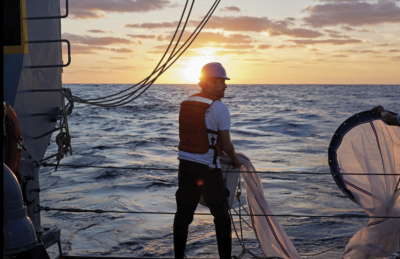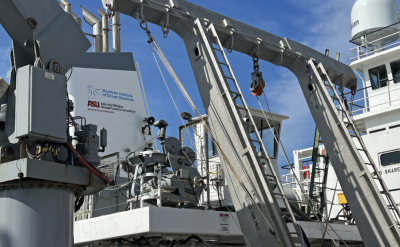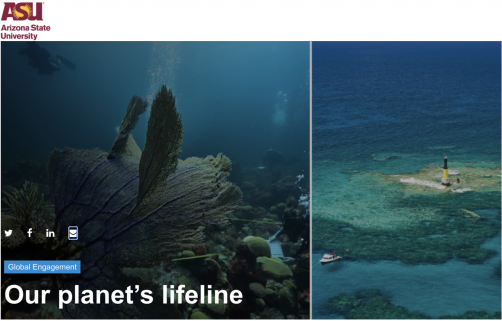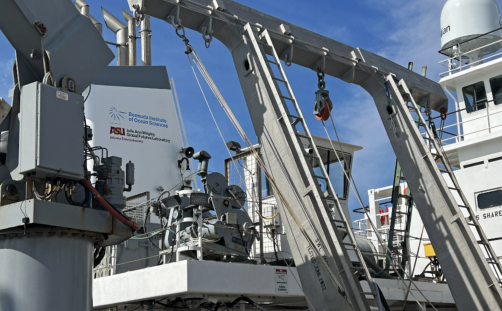Newswise — The ASU Bermuda Institute of Ocean Sciences (BIOS), a 120-year-old institution dedicated to marine science, is leading research into the critical role of zooplankton in carbon sequestration. Located within the pristine waters of the Sargasso Sea and operating under the umbrella of the Julie Ann Wrigley Global Futures Laboratory at Arizona State University (ASU), BIOS continues to be a global leader in marine biodiversity research.
In the midst of the Sargasso Sea, a region in the Atlantic Ocean that encompasses the Bermuda Islands and a hotbed of biodiversity, BIOS's second-year Ph.D. student, Yuuki Niimi, has set his sights on the ocean's smallest but most essential inhabitants: zooplankton.
Niimi's research unfolds aboard the Atlantic Explorer, a 170-foot-long research vessel owned and operated by BIOS. The research takes place during the night when zooplankton ascend from the ocean's depths to the surface to feed on phytoplankton. Overcoming challenges in this unconventional setting, including blinding strobe lights to temporarily incapacitate zooplankton, Niimi and his team are capturing these microorganisms to unlock the secrets they hold.
"While the conditions can be daunting," Niimi acknowledges, "the rewards are immeasurable when we pull up a net filled with this microcosm of life."
Zooplankton, found in a spectrum of sizes and shapes, are the unsung heroes of the ocean's ecosystem. They serve as the foundation of the marine food web and are integral to the biological carbon pump, a crucial process responsible for sequestering carbon dioxide from the atmosphere and storing it in the deep ocean. Recognizing the pivotal roles of different zooplankton species in this process is paramount as ocean conditions continue to evolve.
"Zooplankton are the most abundant animals on Earth," affirms Leocadio Blanco-Bercial, an ASU BIOS researcher. "They sustain all the trophic webs in the oceans."
Susanne Neuer, the founding director of the School of Ocean Futures at ASU, underscores the gravity of this research: "The oceans absorb approximately a quarter to a third of all global emissions through this carbon pump. Without it, we would have already exceeded the 1.5-degree Celsius target set by the Paris climate agreement. The ocean is buying us precious time, and that time is made possible by plankton."
With the ever-increasing impact of climate change on our oceans, BIOS researchers are fervently investigating the biological carbon pump to gain insights into how it may respond to these environmental shifts.
BIOS and ASU's collaborative partnership has flourished for over a decade, with its significance solidified in 2021 when BIOS became a hub for the Julie Ann Wrigley Global Futures Laboratory. This alliance provides ASU students with unparalleled opportunities for hands-on field experience and research, including the study of marine life in the unique ecosystem of Bermuda.
Andrea Brenner, a first-year Ph.D. student at ASU, enthuses about the collaboration: "It was amazing to witness these species during a research cruise, and now I'm learning about them in a classroom setting."
William Curry, President and CEO of ASU BIOS, highlights the importance of not only bringing ocean science to ASU students but also expanding the institution's robotics operations to enhance ocean monitoring.
"The future of ocean observation lies in autonomous robotics and sensor systems," asserts Curry. "ASU BIOS is committed to providing continuous observations of vital biogeochemical processes in the oceans, which are indispensable for our understanding of ocean health."
Oceans, covering more than 70% of our planet, are intricately tied to Earth's well-being. The pioneering research at ASU BIOS emphasizes the urgency of comprehending our oceans and their responses to climate change, offering a pathway to safeguard our planet's future.
Press release adapted from reporting by Kristin Toussaint for ASU.
MEDIA CONTACT
Register for reporter access to contact detailsArticle Multimedia

Credit: ASU
Caption: ASU BIOS research unveils zooplankton's vital role in carbon sequestration, crucial for mitigating climate change and preserving ocean health.

Credit: ASU
Caption: Second-year PhD student Yuuki Niimi studying in Bermuda.

Credit: ASU
Caption: Leo Blanco-Bercial prepares to deploy a net to capture zooplankton.

Credit: ASU
Caption: Leo Blanco-Bercial and Amy Maas, assistant professors, assemble the Multiple Opening and Closing Net and Environmental Sensing System to collect zooplankton at various ocean depths.

Credit: ASU
Caption: The research vessel Atlantic Explorer is used to conduct regular research. The Bermuda Institute of Ocean Sciences, now a part of ASU, has been measuring the temperature, acidity and ocean life in the Atlantic for 120 years.





